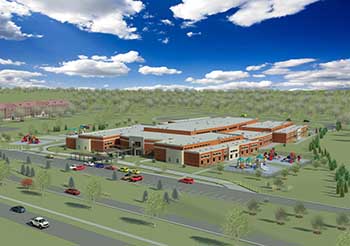Schools Tap into Geothermal Systems for Heating and Cooling

Kingsolver-Pierce Elementary School, Ft. Knox, Kentucky
In the November/December 2007 issue of School Construction News, the “Green Scene” column focused on geothermal heating and cooling for schools. A geothermal engineer described the benefits and various aspects of these energy efficient systems.
Geothermal is well suited to schools because it costs less to operate than traditional heating, ventilation and air-conditioning (HVAC) systems. It is a good partner to masonry construction which has thermal mass characteristics and minimizes temperature swings.
Schools are always looking for ways to save money on operating and maintenance costs. They are designed for long, heavy-duty use, and taxpayers demand durable and efficient structures. The cost of energy already represents a sizeable portion of a school’s operating budget, and is likely to become an even greater expense in the future. Although geothermal heating and cooling systems are initially more expensive, their payback period is relatively quick in terms of a school’s useful life. It is thought to range from five to 12 years.
Masonry can be more or less expensive initially than other building systems, but it is generally considered to require low maintenance and spreads the cost over a long time period, making it efficient over the life of a school. Both of these topics relate to sustainability, which seemingly will influence all aspects of construction for a long time.
Geothermal systems use the earth’s nearly stable temperatures to act as a heat source or a heat sink, so they can heat and cool buildings; using zones allows doing both at the same time.
Mass walls store heat and can prevent temperature swings. Both clay and concrete masonry have this capacity. These are commonly used in schools for both interior and exterior finishes, largely because they are resistant to vandalism, do not promote mold growth, and have long term durability.
A typical temperature curve for masonry walls compared to non-masonry walls shows the reduction in peak temperatures resulting from the use of concrete masonry, and it shows the temperature lag that occurs due to using a mass wall system. This reduces the need for heating and cooling while maintaining a comfortable interior for occupants. The geothermal system does not need to work as hard.
For more information, read School Construction News.